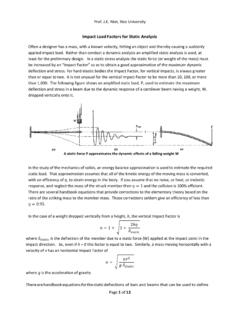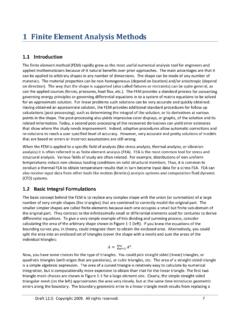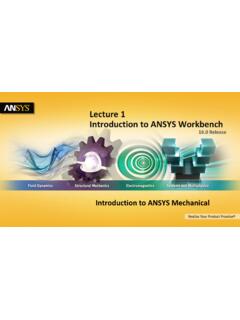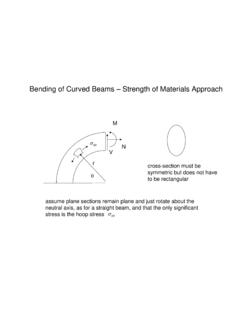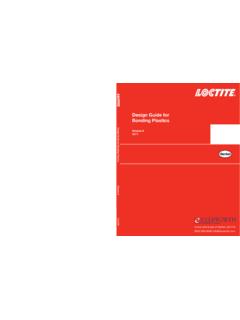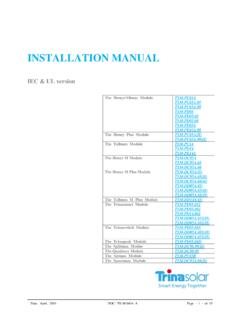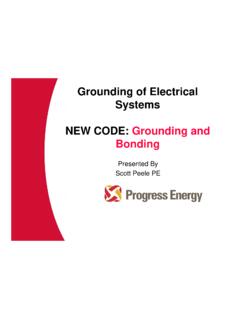Transcription of Lecture 7 Static Structural Analysis - Rice University
1 Lecture 7. Static Structural Analysis Release Introduction to ANSYS Mechanical 1 2015 ANSYS, Inc. February 27, 2015. Chapter Overview In this chapter, performing linear Static Structural analyses in Mechanical will be covered: A. Basics of Linear Static Analysis B. Geometry C. Material Properties D. Contact E. Analysis Settings F. Loads G. Supports H. Load and Support Display I. Contact vs Supports J. Solving Models K. Workshop , Pump Assembly With Contact L. Results and Postprocessing M. Linear vs Non Linear N. Workshop , Using Beam Connections O. Appendix 2 2015 ANSYS, Inc. February 27, 2015. A. Basics of Linear Static Analysis The schematic setup for a linear Static Structural Analysis is shown here.
2 3 2015 ANSYS, Inc. February 27, 2015.. Basics of Linear Static Analysis For a linear Static Structural Analysis , the global displacement vector {x} is solved for in the matrix equation below: K x F . Assumptions made for linear Static Structural Analysis are: [K] , which is the global stiffness matrix, is constant Linear elastic material behavior is assumed Small deflection theory is used {F} , which is the global load vector, is statically applied No time-varying forces are considered No damping effects It is important to remember these assumptions related to linear Static Analysis . Nonlinear Static and dynamic analyses are covered in other training courses.
3 4 2015 ANSYS, Inc. February 27, 2015. B. Geometry In Structural analyses, all types of bodies supported by Mechanical may be used. For surface bodies, thickness must be supplied in the Details view of the Geometry branch. The cross-section and orientation of line bodies are defined within DesignModeler and are imported into Mechanical automatically. 5 2015 ANSYS, Inc. February 27, 2015.. Geometry Mechanical allows a part's stiffness behavior to be defined as rigid/flexible. A rigid body is not meshed with traditional finite elements. Rather it is represented using a single mass element and is thus very efficient in terms of solution times. Parts in an assembly that are included only to transfer loads can be designated as rigid to reduce solution times and model sizes.
4 6 2015 ANSYS, Inc. February 27, 2015.. Point Mass A Point Mass can be added to a model's Geometry branch to simulate parts of the structure not explicitly modeled: Point mass is affected by Acceleration, Standard Earth Gravity, and Rotational Velocity . No other loads affect a point mass. 7 2015 ANSYS, Inc. February 27, 2015. C. Material Properties Young's Modulus and Poisson's Ratio are always required for linear Static Structural analyses: Density is required if any inertial loads are present. Thermal expansion coefficient is required if a temperature load is applied. Stress Limits are needed if a Stress Tool result is present. Fatigue Properties are needed if Fatigue Tool result is present.
5 Requires Fatigue Module add-on license. As shown earlier material properties are assigned in the part details in Mechanical. The user can chose from the dropdown list materials available to this project 8 2015 ANSYS, Inc. February 27, 2015. D. Contact Surface contact elements in Mechanical can be visualized as a skin covering the surfaces of the parts in an assembly. It is these elements that define the behavior when parts are in contact ( friction, bonding , heat transfer, etc.). In Mechanical contact pairs are color coded as shown here. Note, contact is covered in more detail in connection Lecture (L05_connections). Contact Side Target Side 9 2015 ANSYS, Inc.
6 February 27, 2015. Contact - Spot Weld Spot welds provide a means of connecting shell assemblies at discrete points: Spotweld definition is done in the CAD software. Currently, only DesignModeler and Unigraphics define supported spot weld definitions. 10 2015 ANSYS, Inc. February 27, 2015. E. Analysis Settings The Analysis Settings details provide general control over the solution process: Step Controls: Specify the number of steps in an Analysis and an end time . for each step. Solver Controls: Two solvers available (default program chosen): Direct solver (Sparse solver in MAPDL). Iterative solver (PCG solver in MAPDL). Weak springs: Mechanical tries to anticipate under-constrained models.
7 11 2015 ANSYS, Inc. February 27, 2015.. Analysis Settings The Output Controls section of the Analysis settings configures what items are to be written to the results file (defaults shown). Output controls are intended to allow users to write efficient results files containing only the desired information thereby limiting file sizes. The most general results quantities are written by default. Be sure to review the documentation before starting an Analysis to make sure the desired results will be written. Note: the default configuration for output controls can be changed in Tools > Options > Analysis Settings and Solution . 12 2015 ANSYS, Inc. February 27, 2015.
8 F. Loads Loads and supports respond in terms of the degrees of freedom (DOF). available for the elements used. UY. With solid geometry the DOF are X, Y and Z translations (for shells and beams we add rotational DOF rotX, rotY and rotZ). UX. Boundary conditions, regardless of actual names, are always defined in terms UZ. of these DOF. Boundary conditions can be scoped to geometry items or to nodes (depending on load type). Example: a Frictionless Support applied to the face of the block shown would indicate that the Z degree of freedom is no longer free (all other DOF are free). Frictionless surface 13 2015 ANSYS, Inc. February 27, 2015.. Loads Most of loads and supports can be defined by components of by vector.
9 Loads and supports having a direction component can be defined in global or local coordinate systems: In the Details view, change Define By to Components . Then, select the appropriate CS from the pull-down menu. 14 2015 ANSYS, Inc. February 27, 2015.. Loads Acceleration Standard Earth Gravity Rotational Velocity (all bodies) (all bodies) (selected bodies). Units length/time2 length/time2 Radian/second or RPM. A Direction Components Components Defined by Local or global coordinate Vector Vector system Resulting forces: Resulting forces: Notes 15 2015 ANSYS, Inc. February 27, 2015.. Loads Pressure Line Pressure Force Moment Scoping Units Force/area Force/length Mass*length/time Force*length Definition Components Vector Components Components Vector Component direction Vector Vector Normal to Tangential (along line).
10 Positive value If multiple entities are selected, the loads are into surface, evenly distributed negative value acts out of surface. 16 2015 ANSYS, Inc. February 27, 2015.. Loads Hydrostatic Pressure: Applies a linearly varying load to a surface (solid or shell) to simulate fluid force acting on the structure. Fluid may be Internal (contained fluid) or external (submerged body). Internal External 17 2015 ANSYS, Inc. February 27, 2015.. Loads Bearing Load (force): Forces are distributed in compression over the projected area: No axial components. Use only one bearing load per cylindrical surface. If the cylindrical surface is split, select both halves of cylinder when applying the load.
